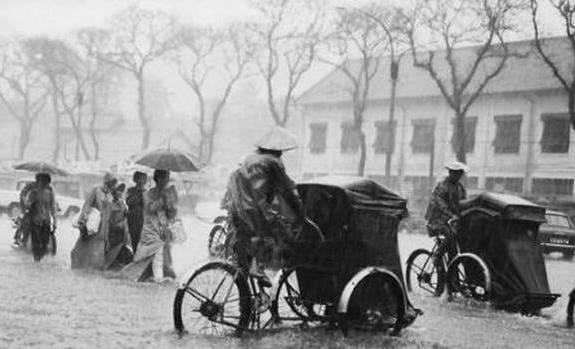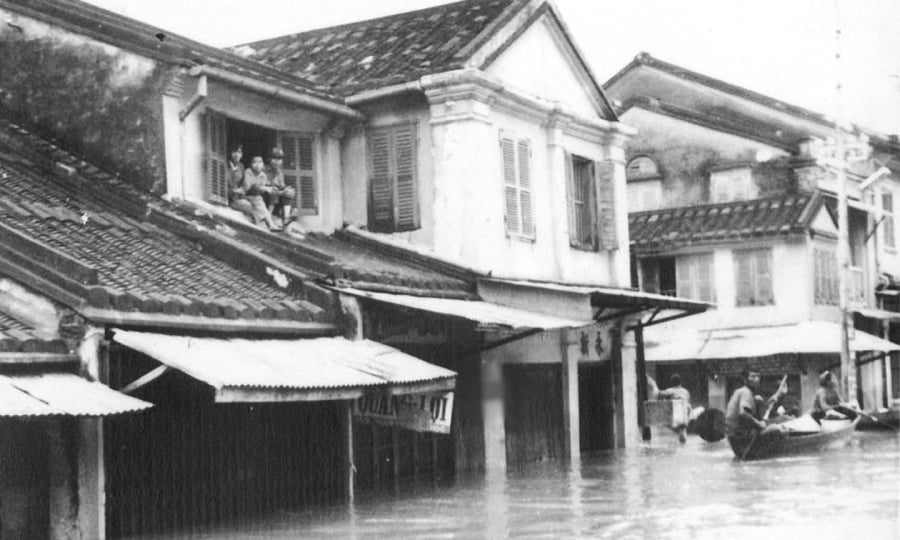The Historic Storm of 1904
Exactly 120 years ago, in 1904, a massive storm hit Southern Vietnam, claiming thousands of lives and causing extensive property damage. This storm is also associated with the saying, “In the Year of the Dragon, there is a storm and flood.”
Specific historical records about this storm are scarce, and most information is derived from later newspaper articles or folk literature.
The Nông Cổ Mín Đàm, one of the first Vietnamese-language newspapers published in Saigon, included a few lines of poetry in its issue dated June 9, 1904: “Out of the blue, a storm arose/The Dragon’s year, the Dragon’s month, a flood/The wind blew so hard, birds were terrified/Even the flat land was flooded, people were panic-stricken…” This was perhaps the earliest Vietnamese-language newspaper to report on the terrifying storm of 1904.
According to the same newspaper, the storm occurred on Sunday, May 1, 1904 (3rd month in the lunar calendar). Subsequent issues, starting from May 5, 1904, recounted the situation during the storm: “On the 16th day of the 3rd month, from 6 am, there was a light drizzle, what people call a ‘cloth-pulling rain’, the sky was overcast without a glimpse of the sun, and it rained until noon. The wind blew fiercely, picking up speed around 2 pm, blowing until houses collapsed and boats capsized. In Saigon, me trees fell everywhere, and in Xom Chieu, houses were scattered across the land. The floodwaters rose in Nha Be and Long Kieng, with cattle and people swept away.”
The Nông Cổ Mín Đàm issue dated May 12, 1904, continued to describe the aftermath of the storm: “In Saigon, countless fishing boats and ferries sank in the river, and on the shore, fallen trees lay everywhere, with coolies unable to clear them fast enough… Gas lamps were all broken and couldn’t be lit, leaving the entire city in darkness. Warehouses, houses, and boats were damaged, with estimated losses amounting to twelve thousand nine hundred and fifty silver dollars.”

The 1904 Storm Caused Flooding in Saigon’s Streets.
Forty years later, in the final issue of the Nam Kỳ Tuần Báo, dated June 8, 1944, writer Hồ Biểu Chánh described the historic storm of 1904. According to this account, the storm caused extensive damage to houses and boats in and around Saigon. Folk poems from that era include lines such as, “Ben Thanh market’s roof was blown away/Gas lamps fell and lay on the road…” and “Meeting you, I now know you’re alive/During the Dragon’s year, the storm and flood made me cry my eyes out…”
Official records from that time estimated that the storm claimed more than 3,000 lives in Saigon alone, with property damage estimated at 40 million silver dollars (which would amount to a staggering 1,000 billion silver dollars in today’s value).
The storm caused the most severe damage in the Gò Công region and its vicinity. Over 60% of the houses in this area were destroyed, 5,000 people drowned, and 80% of livestock perished in the storm…
The Great Flood of 1964
Historical records indicate that in 1964, a massive flood occurred in the Thu Bon and Vu Gia river areas, causing significant damage in the central provinces from Hue to Binh Dinh. This flood ravaged tens of thousands of homes, took the lives of thousands, and buried thousands of hectares of farmland. The districts of Dai Loc, Que Son (including the present-day Nong Son district), Dien Ban, and Duy Xuyen suffered the most severe consequences.
According to statistics at that time, in Dai Loc, more than 1,200 houses were washed away, 253 people lost their lives, and over 45,000 bushels of corn and countless livestock and property were lost to the flood. The communes of Loc Quy, Loc Son, Loc Phuoc, and Loc Hoa were the most severely affected.
In Que Son district, the floodwaters swept away all the houses, property, and crops. The villages of An Toan (in Hiep Thuan commune), Binh Kieu (now in Hiep Hoa commune, Hiep Duc district), and Thach Bich also suffered complete destruction. More than 5,000 people in this area lost their lives or went missing due to the flood.

The Historic Flood of 1964 in Central Vietnam, Known as the “Great Disaster of the Dragon Year.” This Photo Shows Flooding in Hoi An, Quang Nam.
Comrade Pham Thanh Ba, former Chief of Staff of the Quang Da Special Zone, recounted in his memoir, Dấu Ấn Thời Gian (“The Mark of Time”), that at that time, a prolonged heavy rainfall lasting 9-10 days occurred in this region, causing water to rush into the rivers and streams, submerging entire villages. Only a few bamboo groves could be seen protruding from the water’s surface.
Comrade Nguyen Ngoc Chau, Head of the Quang Da Postal Service at the time, who was present in Dien Tien commune during the flood, recalled that on November 7, 1964, the water level in the Yen River dropped significantly. As the waters rose, many people climbed onto their roofs for safety. However, the strong currents even washed away the roofs, taking with them the dozens of people who had sought refuge there.
At that time, in addition to the floods, landslides also buried many villages, along with some dispensaries and offices…
Super Typhoon Yagi of 2024
Yagi is an exceptionally rare super typhoon, according to Mr. Mai Van Khiem, Director of the National Center for Hydro-Meteorological Forecasting. Most super typhoons form in the northern Pacific before entering the East Sea and weakening in intensity. It is uncommon for a typhoon to intensify into a super typhoon in the East Sea.
Typhoon Yagi intensified rapidly. When it entered the East Sea on September 2, it was a category 8 typhoon. More than two days later, on September 5, it had strengthened by eight categories, reaching category 16 and earning the designation of a super typhoon. It maintained super typhoon status for more than a day, an exceptionally long duration for a super typhoon in the East Sea.
According to Mr. Khiem, Typhoon Yagi was the strongest super typhoon to have occurred in the East Sea region in the last 30 years.































